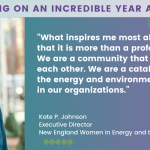Renewable Energy and New England’s Energy Transition
Extreme weather events are on the rise fueled by climate change. Record-breaking heat waves on land and in the ocean, drenching rains, severe floods, years-long droughts, and extreme wildfires are all becoming more frequent and more intense.
The last few years in New England have brought a range of uncommon and record-breaking weather events from devastating floods, tornadoes, extreme temperatures, droughts, air quality alerts due to wildfire smoke, and beaches closed due to bacteria from rain runoff.
Addressing climate change requires us to decarbonize both energy supply and demand by 2050. It is clear that renewable energy and electrification are the key drivers to achieving ambitious decarbonization goals. The pressing need and the complexity of the challenge drew me toward a career in renewable energy development, with a focus on capturing the strong potential of New England’s offshore wind resources.
Offshore wind energy is one part of the solution to a major problem—the critical need to deliver thousands of megawatts of reliable, affordable, renewable energy.
Offshore wind energy has the potential to be the largest ocean-based mitigation solution in both the United States and globally, to decarbonize the electricity sector and address the climate crisis. Offshore wind farms are considered more efficient than onshore wind farms, thanks to the higher wind speeds and greater consistency of winds offshore and lack of physical interference from land or human-made objects.
As I write this, we are closing out on one of the hottest summers ever recorded, with NASA recording June as the hottest month on record. The message for our energy future is clear—we need to urgently reduce emissions of heat-trapping gases from the burning of coal, oil, and natural gas and rapidly shift to renewable energy sources.
Kelly Smith, PE
Onshore Package Manager for SouthCoast Wind
Ocean Winds
© 2025 New England Women in Energy and the Environment (NEWIEE). NEWIEE is a non-profit, tax exempt organization under Section 501(c)(3) of the Internal Revenue Code.





